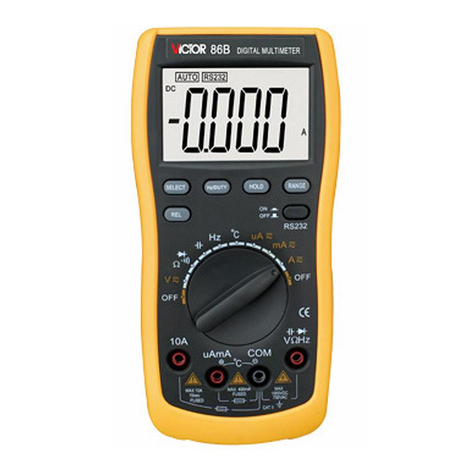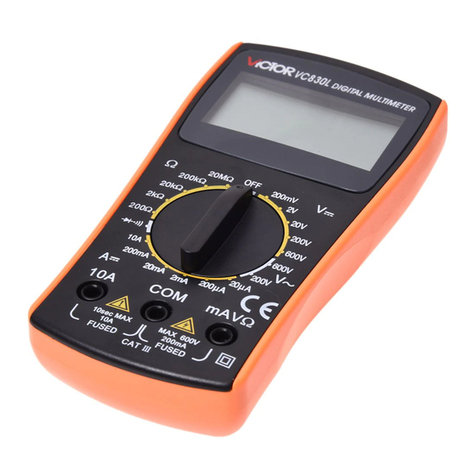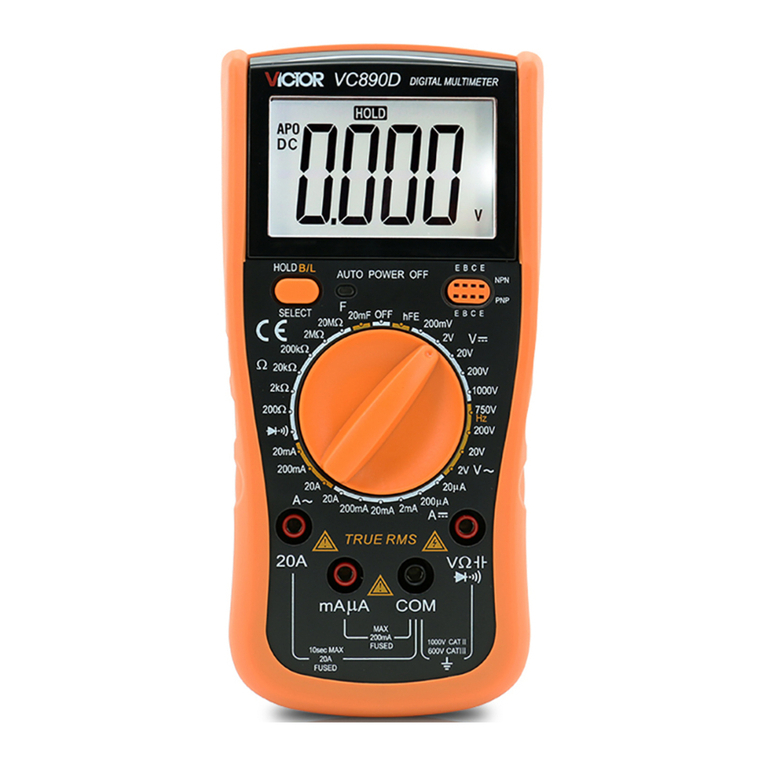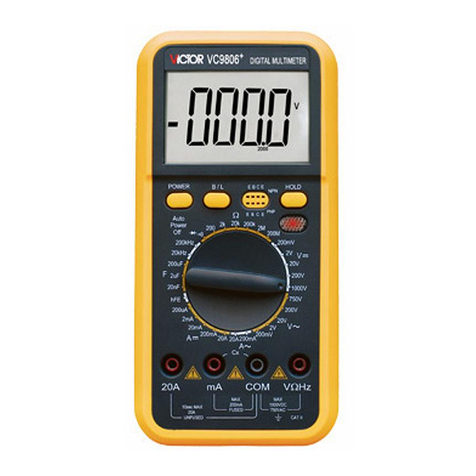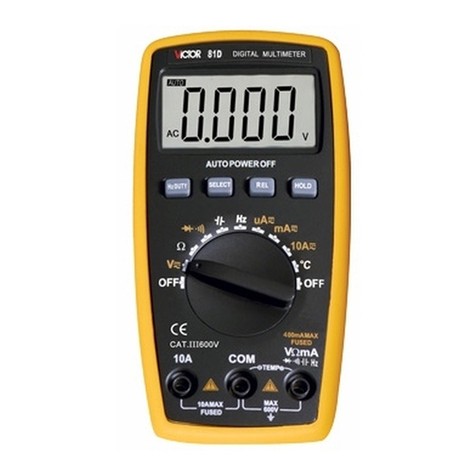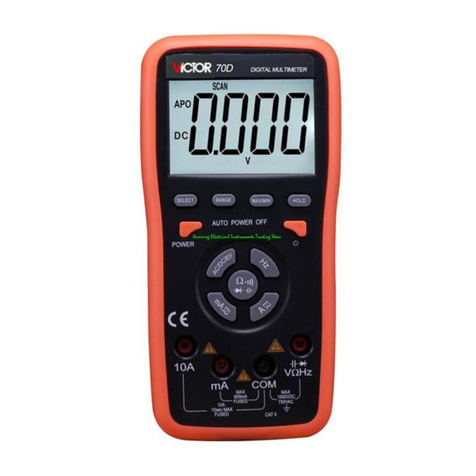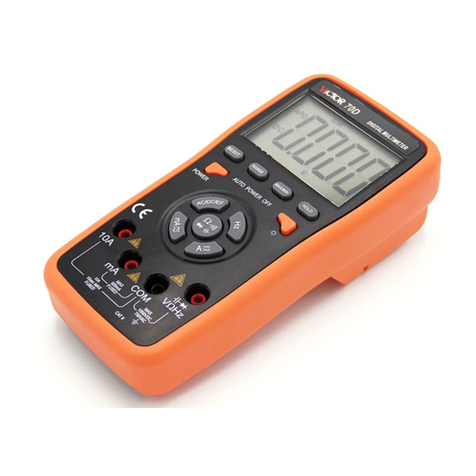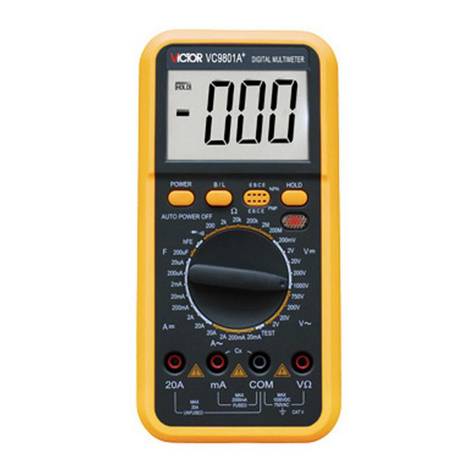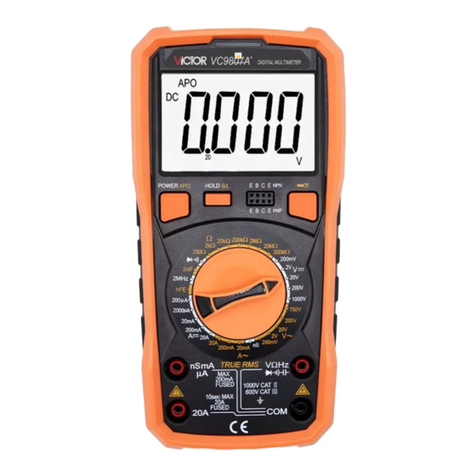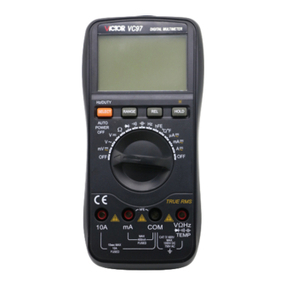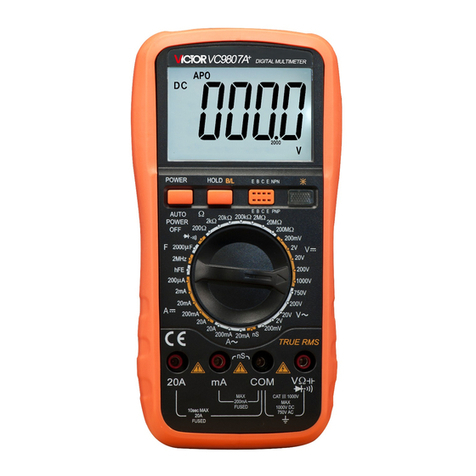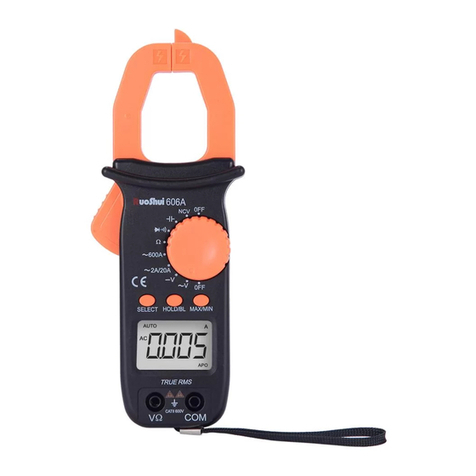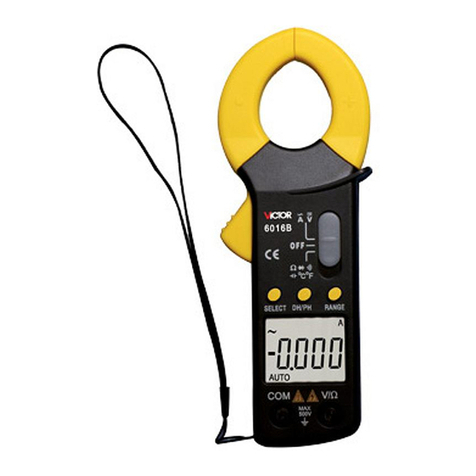1. As showed, “ OL ” indicates the range is over and shall switch to a
higher range.
2. The voltage to be tested shall not over DC 1000V or AC 750V .
The pencils shall be away from the testing point as switching
functions or ranges.
3. When measuring high voltage circuit, any parts of your body
should not touch the high voltage circuit, otherwise it may hurt your
body.
5-3.
5-3.
5-3.
5-3.
Current
Current
Current
Current
measurement
measurement
measurement
measurement
1. Insert the black pencil into the “ COM ” jack, and the red one into
the “ mA ” or “ 20A ” jack.
2. Turn the switch to position “ A ” . If the level of current to be
measured is unknown then select the biggest range and then
decrease the range step by step until getting the value with the
highest resolution.
3. Popup the key “ DC/AC ” to enter into DC mode if measuring DC;
press down the key “ DC/AC ” to set into AC mode.
4. The screen will show the value of current measured if connect in
parallel the pencil to the circuit to be tested; the point touched by
the red pencil is in positive voltage if the value showed is positive.
Notice:
Notice:
Notice:
Notice:
1. As showed, “ OL ” indicates the range is over and shall switch to a
higher range.
2. The input in “ mA ” jack shall not over 200mA and “ 20A ” not over
20A (less than 10 seconds of testing duration) as measuring
current; the pencils shall be away from testing points as switching
function or range.
5-4
5-4
5-4
5-4
Resistance
Resistance
Resistance
Resistance
measurement
measurement
measurement
measurement
1. Insert the black pencil into the “ COM ” jack, and the red one into
the “ V/ Ω /Hz ” jack;
2. Turn the range switch to resistance position, then bride two
pencils at the two ends of the resistor.
Notice:
1. "OL ” will be displayed in screen if the resistance is over the range ,
then you shall increase the range by one step;
2. When input is open circuit, it will display status of overload;
3. When measuring resistance on line, ensure that all power of
circuit tested are turn down and all capacitor are discharged
completely;
4. Never input voltage if in resistance measurement mode!
5. It normal for resistance higher than 1M Ω that the reading data is
not stable for the first several seconds;
5-5
5-5
5-5
5-5
Capacitance
Capacitance
Capacitance
Capacitance
measurement
measurement
measurement
measurement
1. Switch to a proper range, and insert pencils into “ mA ” and “ com ”
jack.
2. Connect the two pencils in parallel to the two ends of the
capacitor. Please pay attention to the polarity, as the “ com ” for
positive and “ mA ” for negative.
Notice:
1. If capacitance exceeds the range selected, “ OL ” will be displayed
in screen ,then you shall increase the range by one step.
2. The LCD may show some rudimental digits upon the starting of
capacitance measurement. It
’
s normal and will not affect the
testing result;
3. If there is serious creepage or capacitor broken down in high
capacitance range, the digits showed will be random and
unstable.
4. Please discharge capacitor completely to avoid device damage
before measuring capacitance.
5-6.
5-6.
5-6.
5-6.
Inductance
Inductance
Inductance
Inductance
measurement
measurement
measurement
measurement
1. Switch to a proper range, and insert pencils into “ mA ” and “ com ”
jack.
2. Bridge the pencils on the two ends of inductor.
Notice:
1. If inductance exceeds the range selected, “ OL ” will be displayed
in screen ,then you shall increase the range by one step.
2. The inductance value measured for identical inductor may be
different if there is different impendence;
3. If in range 2mH, please short pencils and measure lead
inductance, and then subtract the inductance from the value
measured.
4. Avoid measuring small inductor in high range, or the accuracy is
not guaranteed.
5-7.
5-7.
5-7.
5-7.
Temperature
Temperature
Temperature
Temperature
measurement
measurement
measurement
measurement
Turn range switch to “ ℃”
,
insert the cathode(black pin) of
cold end (free end) of thermocouple into “ mA ” jack, anode (red
pin) into “ COM ” jack, put the working end (temperature
measurement end) of thermocouple on the surface or inside the
object to be tes ted. Then you can read temperature from the
screen, and the data is in centigrade.
Notice:
Notice:
Notice:
Notice:
1. As the input end is open, it will show environment temperature if
the operation temperature is higher than 18
18
18
18
℃
,
or normal
temperature if lower than 18
18
18
18
℃.
2.
2.
2.
2.
Please
Please
Please
Please
never
never
never
never
replace
replace
replace
replace
temperature
temperature
temperature
temperature
sensor,
sensor,
sensor,
sensor,
or
or
or
or
the
the
the
the
accuracy
accuracy
accuracy
accuracy
is
is
is
is
not
not
not
not
guaranteed;
guaranteed;
guaranteed;
guaranteed;
3.
3.
3.
3.
Never
Never
Never
Never
input
input
input
input
voltage
voltage
voltage
voltage
if
if
if
if
in
in
in
in
temperature
temperature
temperature
temperature
mode.
mode.
mode.
mode.
5-8.
5-8.
5-8.
5-8.
Frequency
Frequency
Frequency
Frequency
measurement
measurement
measurement
measurement
1. Insert pencils or shielded cable into “ COM ” and “ V/ Ω /Hz “ jack;
2. Turn range switch to frequency position and bridge pencils or
cables over the signal source or load tested.
Notice:
1. The device can still work if the input is higher than 10V virtual
value, but the accuracy is not guaranteed;
2. In noise environment, you'd better use shield cable to measure
small signal;
3. When measuring high voltage circuit, any parts of your body
should not touch the high voltage circuit, otherwise it may
hurt your body.
4. Never input voltage higher than 250V DC or AC peak value,
otherwise it may damage your device.
5-9.
5-9.
5-9.
5-9.
Triode
Triode
Triode
Triode
hFE
hFE
hFE
hFE
1. Turn the range switch to “ hFE ” position;
2. Insert testing accessory into “ mA ” and “ com ” jack. Please pay
attention to the polarity, as the “ com ” for positive and “ mA ” for
negative.
3.
To
determine the triode's type, NPN or
PNP,
insert the emitting,
base and collector electrode into the corresponding jacks in
testing accessory.
5-10.
5-10.
5-10.
5-10.
Diode
Diode
Diode
Diode
and
and
and
and
open
open
open
open
circuit
circuit
circuit
circuit
test
test
test
test
1. Insert the black pencil into “ COM “ jack, and the red one into the
“ V/ Ω /Hz “ jack (Notice: the red pencil is anode);
2. Turn the range switch to position “ ”
,
connect pencils in
parallel to the diode tested, with the red pencil to the anode and
the black to cathode, then the reading value will be approximate
forward voltage drop of the diode;
3. Connect pencils to two points of the circuit to be tested, if buzzer
sounds, then the resistance between the two points is lower
than (70 ± 20) Ω .
5-11.
5-11.
5-11.
5-11.
Peak
Peak
Peak
Peak
value
value
value
value
holding
holding
holding
holding
